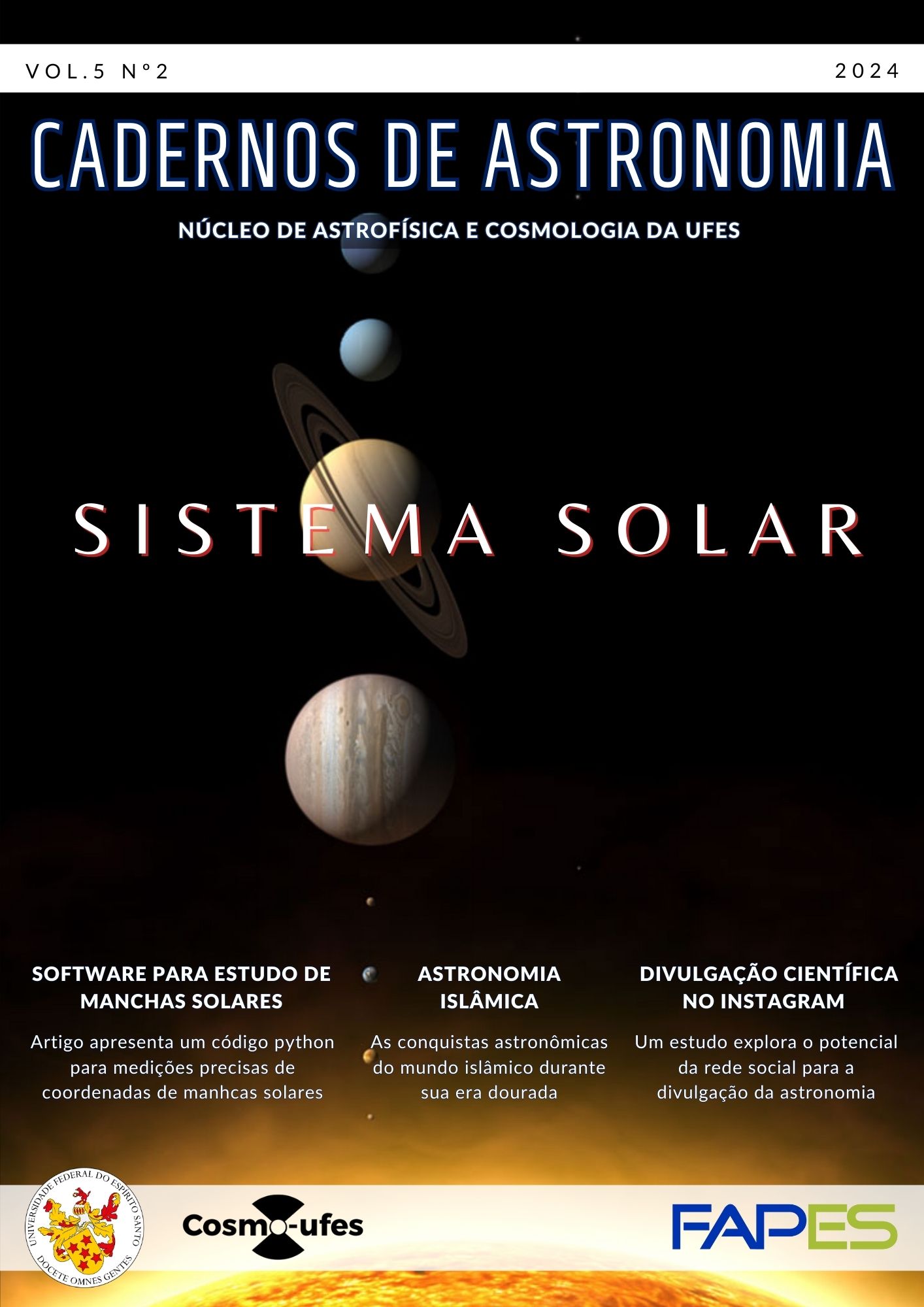Alinhamento automático de imagens do disco solar e determinação precisa de coordenadas heliográficas de manchas solares com PySDIA
DOI:
https://doi.org/10.47456/Cad.Astro.v5n2.44352Palavras-chave:
telescópio de pequena abertura, manchas solares, coordenadas heliográficas, PySDIAResumo
Este trabalho apresenta o PySDIA (Python Solar Disc Image Alignment), um código Python automatizado para alinhamento e correção rotacional de imagens de discos solares capturadas com telescópios de pequena abertura. Aplicamos o PySDIA a um conjunto de 101 imagens próprias, abrangendo o período de 8 de novembro de 2022 a 4 de dezembro de 2023, para caracterizar e extrair coordenadas heliográficas de 250 manchas solares. Para validar nossos resultados, comparamos nossos dados com medições do SDO extraídas usando o software HelioViewer v2.2. O PySDIA alinhou e rotacionou efetivamente nossas imagens, alcançando excelente correlação entre as coordenadas das nossas manchas solares e as do SDO. Nossos resultados demonstram que medições precisas de coordenadas de manchas solares podem ser obtidas ao longo do tempo usando equipamentos prontamente disponíveis, permitindo contribuições independentes para registros e estudos de manchas solares.
Referências
X. Zhentao, Solar observations in ancient China and solar variability, Philosophical Transactions of the Royal Society of London. Series A, Mathematical and Physical Sciences 330(1615), 513 (1990).
J. M. Vaquero e M. Vázquez, The Sun recorded through history, vol. 361 (Springer Science & Business Media, 2009).
D. V. Hoyt e K. H. Schatten, The role of the sun in climate change (Oxford University Press on Demand, 1997).
H. Schwabe, Sonnenbeobachtungen im jahre 1843. von herrn hofrath schwabe in dessau, Astronomische Nachrichten 21, 233 (1844).
R. C. Carrington, Observations of the spots on the Sun: from November 9, 1853, to March 24, 1861, made at Redhill (Williams and Norgate, 1863).
J. L. Jenkins, The Sun and How to Observe It (Springer, 2009).
J. Wilkinson, New Eyes on the Sun: A Guide to Satellite Images and Amateur Observation (Springer, 2012).
L. Macdonald, How to observe the Sun safely (Springer Science & Business Media, 2012).
E. W. Maunder, Note on the distribution of sun-spots in heliographic latitude, 18741902, Monthly Notices of the Royal Astronomical Society, Vol. 64, p. 747-761 64, 747 (1904).
R. Arlt, The sunspot observations by Samuel Heinrich Schwabe, Astronomische Nachrichten 332(8), 805 (2011).
D. H. Hathaway, The Solar Cycle, Living Reviews in Solar Physics 12(1), 1 (2015).
S. Mandal et al., Kodaikanal digitized whitelight data archive (1921–2011): Analysis of various solar cycle features, Astronomy & Astrophysics 601, A106 (2017).
L. van Driel-Gesztelyi e M. J. Owens, Solar Cycle, Oxford Research Encyclopedia Of Physics. (2020).
J. Curto, M. Blanca e E. Martínez, Automatic sunspots detection on full-disk solar images using mathematical morphology, Solar Physics 250, 411 (2008).
T. Barreto e G. Almeida, Astrofotografia: técnicas e aplicações, Scientia Plena 5(11) (2009). Disponível em https://scientiaplena.org.br/sp/article/view/737, acesso em ago. 2024.
G. Bradski, The OpenCV Library, Dr. Dobb’s Journal of Software Tools (2000).
D. Ratledge, Digital Astrophotography: The State of the Art (Springer Science & Business Media, 2006).
A. M. Price-Whelan et al., The Astropy Project: Building an open-science project and status of the v2. 0 core package, The Astronomical Journal 156(3), 123 (2018).
The SunPy Community et al., The SunPy Project: Open Source Development and Status of the Version 1.0 Core Package, The Astrophysical Journal 890, 68 (2020).
J. D. Hunter, Matplotlib: A 2D graphics environment, Computing in Science & Engineering 9(3), 90 (2007).
R. Pucha, K. Hiremath e S. R. Gurumath, Development of a code to analyze the solar white-light images from the Kodaikanal observatory: Detection of sunspots, computation of heliographic coordinates and area, Journal of Astrophysics and Astronomy 37, 1 (2016).
P. Meadows, Helio Viewer v2.2 User Guide (2023). Disponível em https://www.petermeadows.com/html/software.html, acesso em ago. 2024.
M. E. G. Martins e J. Rodrigues, Coeficiente de correlação amostral, Revista de Ciência Elementar 2(2), 34 (2014).
M. R. Spiegel, Estatística (Makron, São Paulo, 1993), 3ª ed.
Downloads
Publicado
Edição
Seção
Licença
Copyright (c) 2024 Cicero Dário Grangeiro, Tharcísyo Sá e Sousa Duarte, Jefferson Soares da Costa, Hugo Rodrigues Coelho

Este trabalho está licenciado sob uma licença Creative Commons Attribution 4.0 International License.






